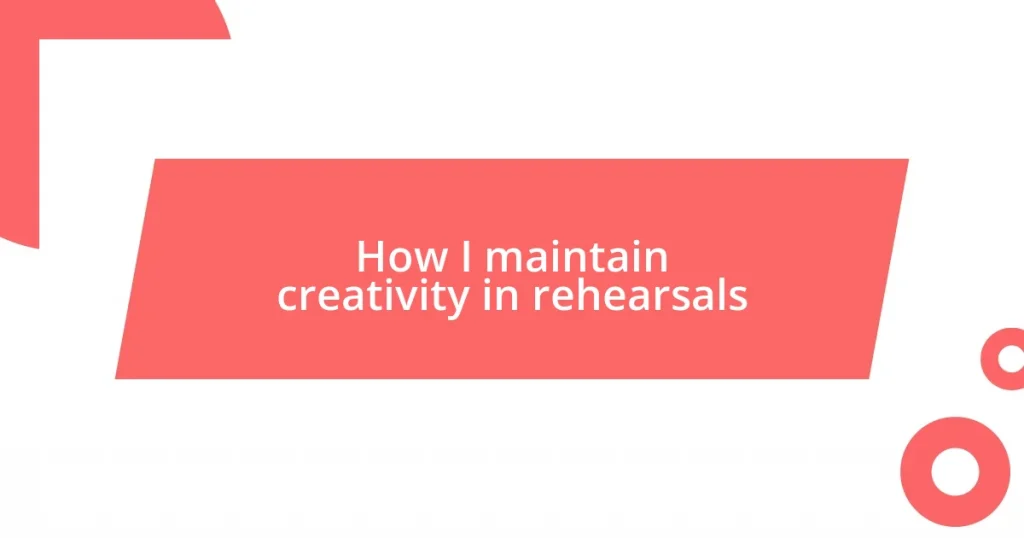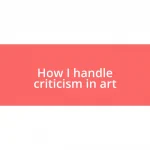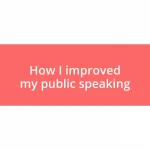Key takeaways:
- Establishing a creative mindset involves openness, vulnerability, and setting rituals that enhance focus and spontaneity.
- Incorporating improvisation techniques and visual aids during rehearsals can deepen character exploration and enhance storytelling.
- Engaging in collaborative activities, incorporating feedback, and embracing diversity stimulate collective creativity and promote adaptability in the rehearsal process.
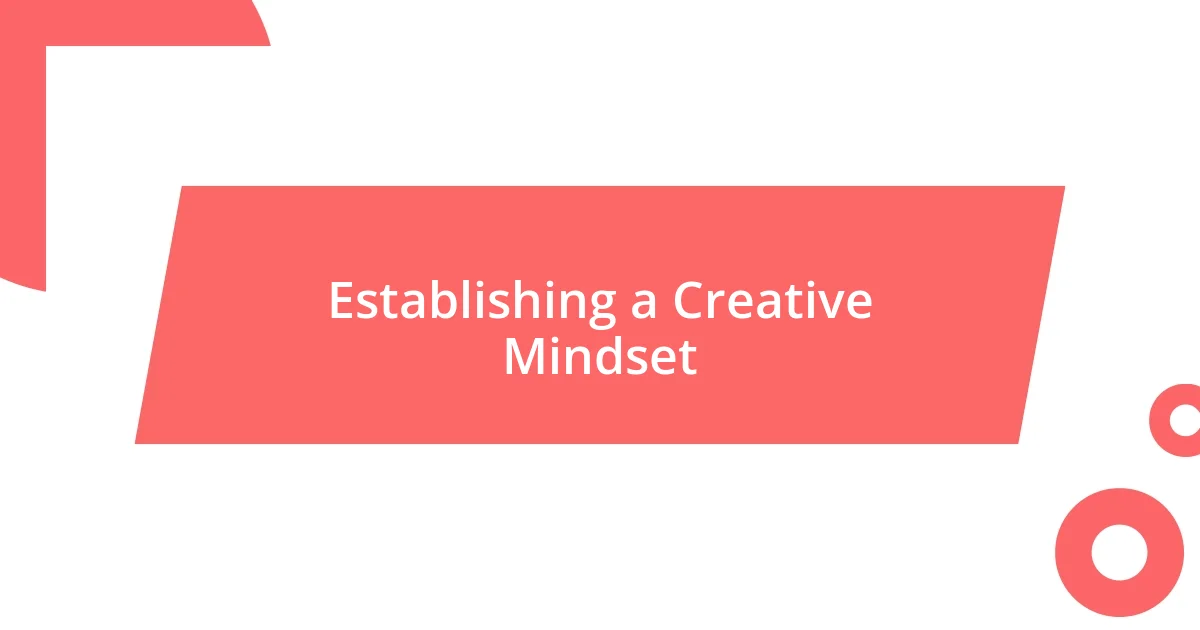
Establishing a Creative Mindset
Establishing a creative mindset starts with an open heart and a willingness to explore. I remember the first time I stepped into a rehearsal space, feeling that familiar flutter of anxiety mixed with excitement. I found myself asking, “What if this rehearsal could be an adventure?” This shift in perspective allows the mind to play rather than perform, fostering a sense of freedom and innovation.
Another key aspect is embracing vulnerability. I recall a moment when I shared a seemingly silly idea with my troupe, expecting laughter rather than support. To my surprise, it sparked a breakthrough session that transformed our entire approach. This experience taught me that cutting through fear can unlock creativity and deepen collaboration; after all, isn’t the purpose of rehearsal to discover new possibilities together?
Lastly, creating a ritual that signals “creativity time” can be empowering. For me, it’s a simple act of lighting a candle at the beginning of each rehearsal. I find that this small gesture keeps my mind focused and invites spontaneity into the room. How do you set the stage for inspiration? Explore what rituals resonate with you and elevate your creative process.
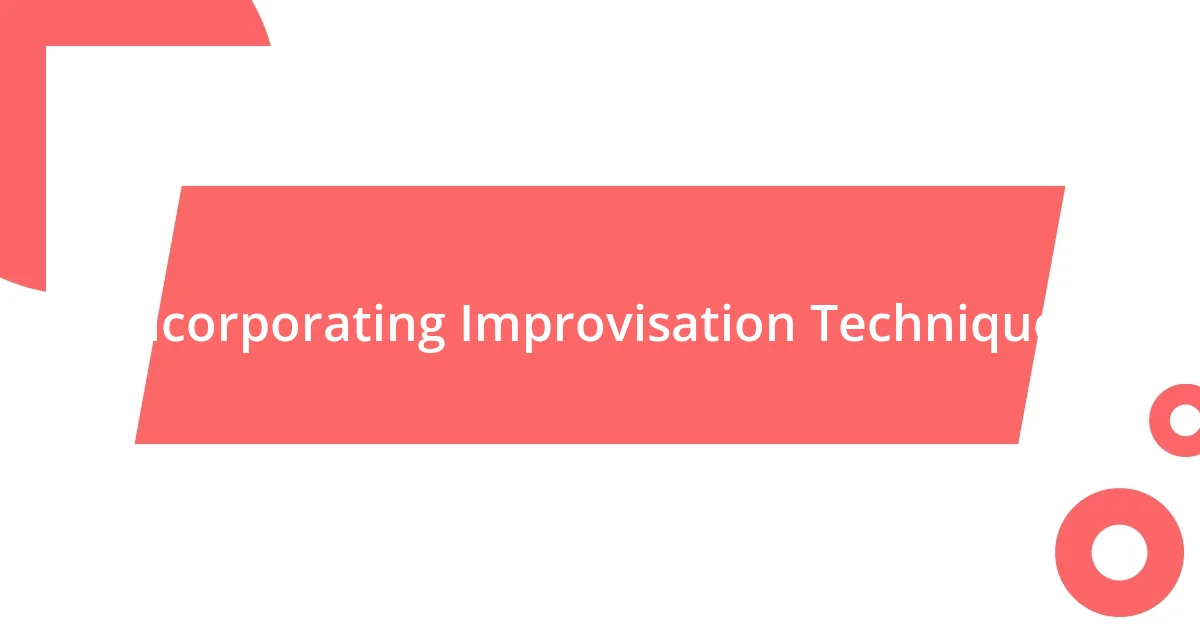
Incorporating Improvisation Techniques
Incorporating improvisation techniques into rehearsals can ignite creativity in unexpected ways. One evening, I vividly recall a session where we tossed our script aside to explore character motivations through improvisation. By diving into our characters’ backstories on the fly, we uncovered layers of depth that scripted lines just couldn’t express. This experience reminded me that improvisation isn’t just a tool; it’s a gateway to understanding and exploring our characters authentically.
Here are some effective improvisation techniques I’ve found beneficial:
-
Yes, and…: This classic improv rule encourages building on each other’s ideas, promoting collaboration and openness.
-
Role Reversals: Switching roles with other cast members can provide fresh perspectives and deeper connections to the material.
-
Emotion-Based Prompts: We sometimes explore scenes by starting with an emotion rather than a specific line, allowing feelings to shape our expressions organically.
-
Spontaneous Backstories: Creating quick, improvised histories for our characters can unlock new motivations and reactions in our scripts.
-
Physicality Exercises: Engaging in movement-based improvisation encourages freedom and can lead to surprising, creative choices in performance.
These techniques not only break the routine but cultivate an environment ripe for exploration, ultimately enhancing our final performance.
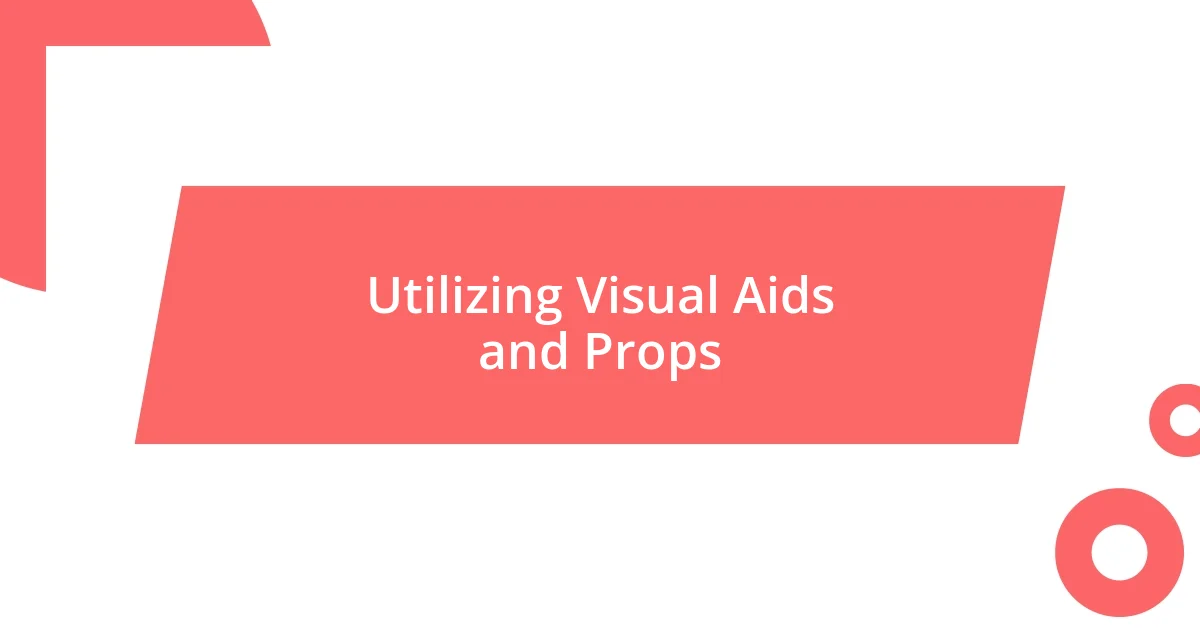
Utilizing Visual Aids and Props
Utilizing visual aids and props can significantly enhance the creative process during rehearsals. I recall a time when we decided to incorporate a few simple props into our scene work. As we used a hat, a cane, and even some fabric, the energy in the room shifted. Suddenly, the characters became more vivid and our interactions felt more authentic. It’s amazing how a tactile element can inspire us to think differently about our roles and relationships on stage.
In my experience, visual aids serve not just as props but as storytelling tools. For instance, I once brought a large picture of a setting that represented our character’s home. As we stood in front of it, the mood changed, and we found ourselves truly immersing in the story. This connection allowed us to explore our emotions more deeply, enhancing our performance. I genuinely believe that these visual components provide a crucial anchor to both our creativity and our narrative dynamics.
When considering the role of props, it’s essential to acknowledge the difference between using them as mere objects and seeing them as extensions of our characters. Each prop holds potential meanings that can shift a scene dramatically. I remember a rehearsal where we incorporated a mirror into our performance. Instead of just a reflective surface, it became a motif of self-discovery, helping us to express underlying themes we hadn’t anticipated before. Visual aids can truly guide us to unexpected creative territories.
| Visual Aids | Props |
|---|---|
| Enhance storytelling by providing context | Bring characters to life through tangible representations |
| Encourage movement and physicality | Facilitate emotional connection in scenes |
| Promote visual engagement for both actors and audience | Require active participation and improvisation |
| Support thematic elements and character arcs | Serve as tools for exploration and discovery |
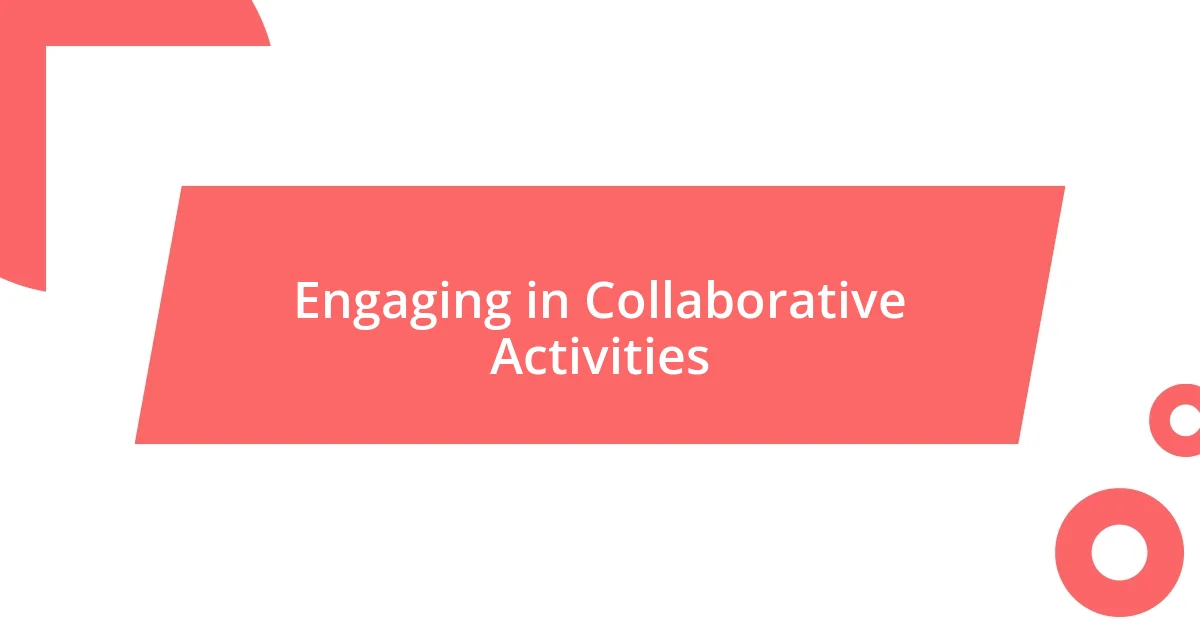
Engaging in Collaborative Activities
Engaging in collaborative activities has transformed the way I approach rehearsals, breathing new life into our creative process. I remember one instance where we divided into small groups to brainstorm character arcs. As we shared our ideas, it was fascinating to witness how each person’s perspective enriched our understanding. It left me wondering—how often do we overlook the power of collective creativity? I realized that collaboration not only deepens our connection to the material but also fosters a sense of belonging among the cast.
In another rehearsal, we chose to play a game that required us to create a story together, with each person contributing a line. Initially, it felt chaotic, yet as we settled into the rhythm, something magical happened. Ideas connected in ways I never anticipated. I still chuckle when I think about how a simple suggestion about a runaway goat led to our characters embarking on an unexpected adventure. There’s something wonderfully liberating about letting go of control and witnessing a cohesive narrative unfold in real time.
I’ve also found that incorporating feedback sessions can spark creativity in surprising ways. After we finish a scene, we dedicate a few moments to share thoughts on what worked and what didn’t. I recall a time when criticism sparked a heated discussion about emotional authenticity that ultimately turned into a breakthrough moment for our character portrayals. Isn’t it amazing how open dialogue can illuminate new angles we hadn’t previously considered? Through these collaborative endeavors, I’ve learned that creativity truly flourishes when we come together, each contributing our unique spark.

Scheduling Regular Reflection Sessions
Scheduling regular reflection sessions is something I’ve come to value immensely in my creative process. I remember a time when we dedicated every Friday to reflect on our week’s rehearsals. Initially, I was skeptical—would sitting around talking really spark creativity? But as we opened up about our experiences, I found that these discussions transformed our perspective, revealing insights that I hadn’t considered before.
During one of these sessions, we ended up discussing how a particular scene felt stale. It was during this reflection that someone suggested tweaking the dialogue to make it more organic. As we explored that idea, it dawned on me just how powerful it can be to have open conversations about our work. I found it heartening to witness my peers light up with new ideas, and I couldn’t help but think—what might we miss without this time for introspection?
I’ve seen firsthand how these moments of reflection allow us to reconnect with our creative intentions. There was a particularly emotional day when we shared what the play meant to each of us personally. I realized that bringing our own stories to the table created a layer of authenticity in our performances. So, why not schedule these sessions regularly? If I’ve learned anything, it’s that taking the time to reflect not only revitalizes our passion but also deepens our connection to the narrative we’re crafting.
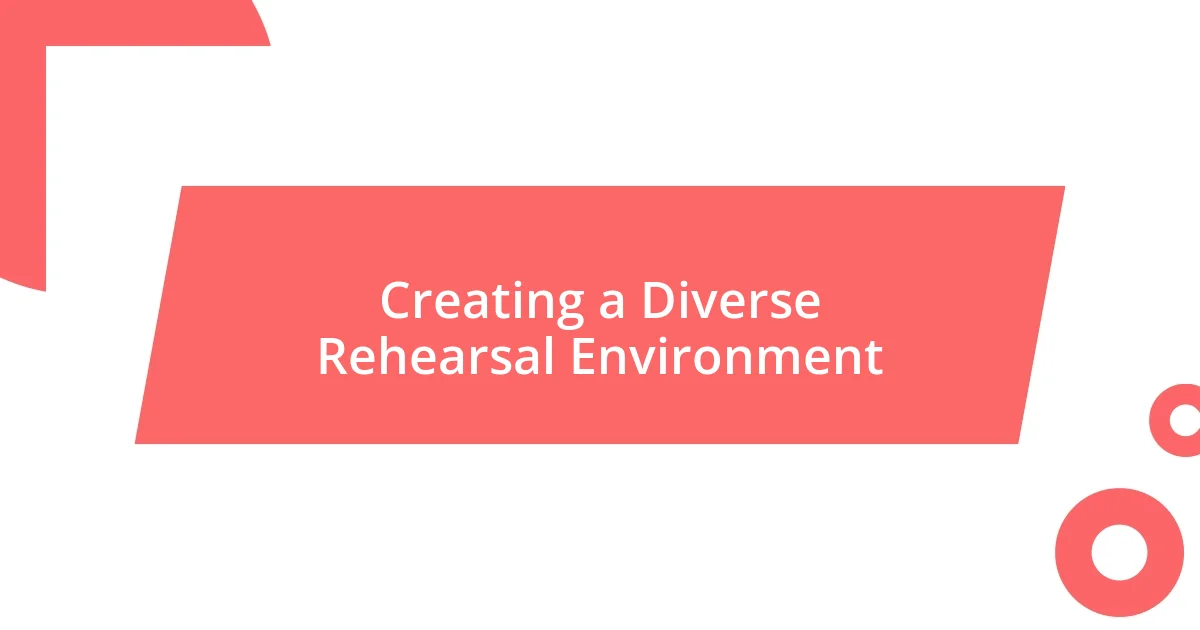
Creating a Diverse Rehearsal Environment
Creating a diverse rehearsal environment has always been one of my main priorities. I remember a time when we invited a guest director from a completely different background to lead a session. Their unique approach challenged my usual practices, pushing the entire ensemble to think differently about character motivations. It really struck me—how often do we limit ourselves by sticking to familiar methods? Diversity not only fosters creativity but also opens us up to new ways of thinking.
I also believe that diversity in skill sets amplifies our rehearsals. One day, we had a dancer join our cast, and their physicality began to influence our blocking. As I watched them weave movement seamlessly into our scenes, I felt this wave of inspiration wash over me. It made me contemplate—what other talents might be lurking within our team? Those moments of cross-disciplinary interaction spark creativity that often leads to unexpected breakthroughs in storytelling.
Being intentional about inclusivity is crucial, too. I once facilitated a brainstorming session where everyone wrote down their unique ideas anonymously. The delight on their faces when we revealed the contributions was unforgettable. It made me realize that sometimes the best ideas come from those who might hesitate to share in a larger group. Have you ever noticed how different perspectives can shift the energy in a room? By creating a safe space for every voice, we cultivate an environment rich in creativity and innovation.
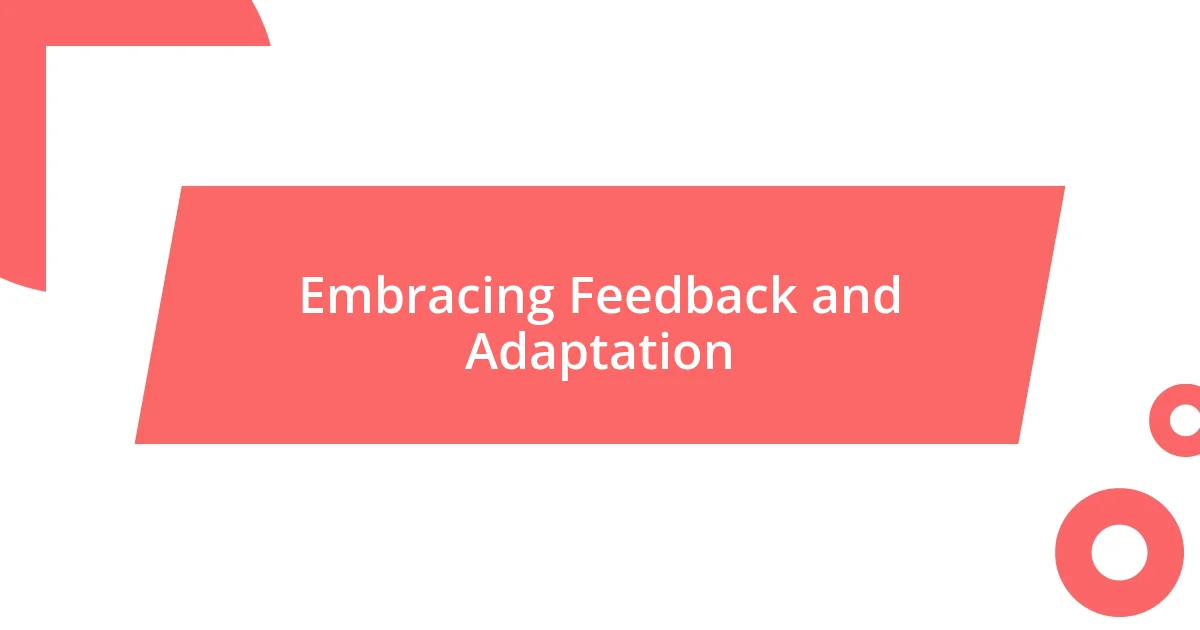
Embracing Feedback and Adaptation
Embracing feedback is something I’ve learned can profoundly impact our collective creativity. During one rehearsal, after presenting a new scene, a fellow actor shared their thoughts candidly but kindly. Their perspective highlighted nuances I hadn’t even considered. It reminded me—what if we viewed feedback not as criticism, but as a pathway to deeper exploration? That shift in mindset opened up lively discussions that transformed our work, creating a sense of shared ownership among us.
Adaptation is equally essential. I recall a rehearsal where our performance felt flat because the energy was off. Rather than sticking stubbornly to our planned routine, we decided to take a moment to regroup and hear each other out. This organic adjustment led us to explore a more playful direction that infused our characters with renewed vibrancy. Why do we often hesitate to change course? I’ve found that embracing adaptability can lead us to uncover moments of genuine magic that we might not have initially envisioned.
It can be challenging, though, to embrace this cycle of feedback and adaptation. I remember feeling a sense of vulnerability when opening up to critique. I had to remind myself of the greater goal: creating something beautiful together. How often do we let pride hold back our growth? Through this experience, I learned that vulnerability in creativity breeds authenticity and strength. Together, we foster resilience, adapting our ideas and performances until they resonate in ways we hadn’t anticipated.










